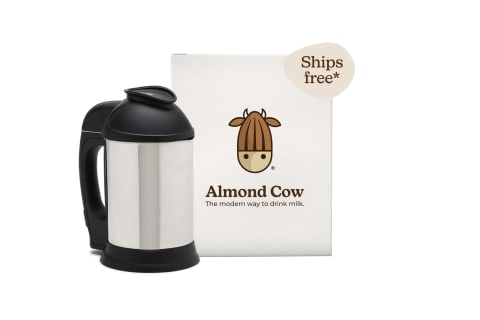A lot has changed since; I find my vegan recipes on TikTok, and that small dairy-free section is triple the size. Yet I don’t actually take advantage of my seemingly endless selection of dairy-free milks and creamers. Instead, I stock my fridge with fresh coconut, cashew, and almond milk from my Almond Cow Machine. Here’s why I recommend the Almond Cow to everyone I know—dairy-free or not. If you’re wondering how such a simple process justifies the hefty price tag, it all comes down to the simplicity of the machine—and the benefits it brings. From start to finish, the entire milk-making process takes less than five minutes with the Almond Cow, including the time spent measuring out ingredients. And whereas store-bought milk alternatives often have preservatives, sweeteners, and/or oils to get the rich, shelf-stable consistency, milks from the Almond Cow have as few (or as many) ingredients as you want. While the milks only last about three to four days in the fridge due to the simple ingredient list, I’ve found it’s a small price to pay for nut milks that actually taste like nuts. Despite the name, the Almond Cow isn’t limited to nut milks. I’ve previously repurposed the device as a mini mocktail maker, using the basket to blend fresh lime and jalapeño into a spicy sour mix. The brand’s recipe book also recommends testing out ingredients, like pea and corn, to expand your definition of alternative milks even further. The next step is measuring out nuts or grains to put into the filter basket; you’ll need the same regardless of the liquid amount used. This is also when you’ll need to decide how you want your milk to taste. The brand recommends using either maple syrup or dates to naturally sweeten your beverage (I’ve even used agave before in a pinch), as well as a dash of salt to help enhance the flavor. I personally like incorporating vanilla, too, as it gives the final product just a bit of extra oomph. When your filter basket is full, you twist it onto the bladed lid; all the blending and straining will happen within this piece. Once you place the lid back onto the canister, you’re ready to begin. Simply press the button on the lid to kick-start operation. The machine runs automatically for three 15-second cycles, blinking green for each new cycle. Although the device is slightly high-pitched, it’s not too loud. My dog runs out of the room, but I’m fine to continue in the kitchen as the Almond Cow operates. Altogether it takes less than 60 seconds to complete the entire process—so it’s not disruptive. I personally like to dump my milk into a secondary container right away, so I can toss it into the fridge to chill. However, I typically put the filter basket and lid back onto the canister, so the pulp continues to strain out excess liquid. This ensures I get every last drop of my creation. It also puts the pulp on the drier side, which makes it easier for repurposing into crackers, sauces, and my personal favorite, “gruel.” (FYI, this is why I consider the Almond Cow a great gift for those trying to reduce their footprint.) Despite having access to countless kitchen appliances through my job as a product reviewer, I give valuable counter space to the Almond Cow (though I should note it’s smaller than a typical blender). It’s a worthy investment for anyone who spends a lot of money on dairy-free alternatives: It’s more cost-efficient than purchasing milks at the store, and you can control every ingredient going into the recipe, which can’t be said for store-bought options. However, I should note that not all milks reach the same consistency with the Almond Cow. Almonds have a lower fat content than many other nuts, so they produce a watery consistency, especially without additives. My preferred nuts for getting the creamiest finish are cashews. I also love a blend of coconut and cashews, but the coconut is definitely a noticeable flavor. Another warning: Not all pulp is the same. When repurposing the pulp, it’s important to factor in the flavor of the beverage. Sweet vanilla milks will produce pulp that tastes the same—so it may be weird in a cheese sauce or other savory recipe. (If you’re desperate, a vanilla cashew pulp can transform into a queso, but I’d recommend adding a strong flavor like roasted red pepper.)




